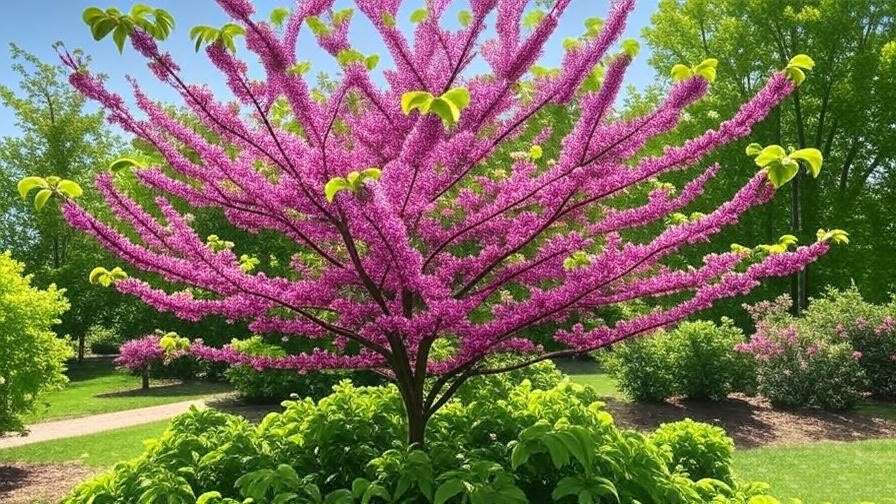Imagine stepping into your garden in early spring, greeted by a burst of vibrant pink and purple blooms that transform your yard into a living masterpiece. Redbud trees, known for their stunning flowers and heart-shaped leaves, are the perfect addition to any landscape, offering beauty and ecological benefits. If you’re exploring the types of redbud trees to find the ideal fit for your garden, you’re in the right place. This comprehensive guide dives deep into the best redbud varieties, their unique features, and expert care tips to ensure your tree thrives. Whether you’re a homeowner, landscaper, or gardening enthusiast, this article will help you choose and nurture the perfect redbud for your space. Let’s get started! 🌿
What Makes Redbud Trees Special? 🌿
Overview of Redbud Trees (Cercis species)
Redbud trees, belonging to the Cercis genus, are deciduous trees or shrubs prized for their dazzling spring blooms and attractive foliage. Native to North America, Asia, and parts of Europe, these trees are celebrated for their adaptability and ornamental appeal. Their heart-shaped leaves and vibrant flowers—ranging from pink to purple to white—make them a favorite for gardeners. Redbuds typically grow 20–30 feet tall, though dwarf varieties are perfect for smaller spaces. Their early spring blooms, often appearing before the leaves, attract pollinators like bees and butterflies, making them a valuable addition to eco-friendly gardens.
Key Features to Consider When Choosing a Redbud
Selecting the right redbud tree involves understanding your garden’s needs and the tree’s characteristics. Consider these factors:
- Size and Growth Patterns: Redbuds range from compact shrubs to medium-sized trees. Dwarf varieties like ‘Ace of Hearts’ suit small yards, while standard ones like the Eastern Redbud work well in larger spaces.
- Bloom Colors and Seasonal Interest: Flowers vary from soft pink to deep magenta, with some varieties offering striking fall foliage or decorative seed pods.
- Hardiness Zones: Most redbuds thrive in USDA zones 4–9, but some, like the Western Redbud, are more drought-tolerant and suited for arid climates.
The Best Types of Redbud Trees for Your Garden 🌺
Eastern Redbud (Cercis canadensis) 🌸
The Eastern Redbud, native to eastern North America, is a classic choice for its breathtaking pink-purple blooms that emerge in early spring. Growing 20–30 feet tall and wide, it’s ideal for traditional landscapes, suburban yards, or naturalized areas. Its heart-shaped green leaves turn golden in fall, adding seasonal charm.
- Popular Cultivars:
- ‘Forest Pansy’: Known for its deep purple foliage, this variety adds dramatic color year-round.
- ‘Alba’: Features rare white flowers, perfect for a softer aesthetic.
- Best For: Large yards, woodland gardens, or as an understory tree.
- Care Tips: Plant in well-drained soil with full sun to partial shade. Prune in late winter to maintain shape and remove deadwood. Watch for canker disease in humid climates.
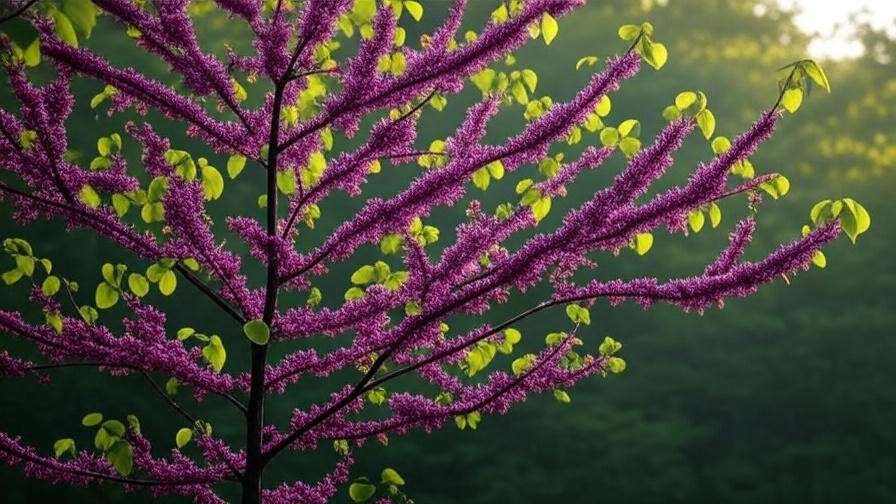
Western Redbud (Cercis occidentalis) 🌄
The Western Redbud, native to the American Southwest, is a drought-tolerant gem suited for arid regions. Growing 10–20 feet tall, its compact size and vibrant magenta blooms make it a standout in xeriscaped gardens or sunny slopes. Its leaves turn reddish-orange in fall, enhancing its appeal.
- Best For: Low-water gardens, rocky soils, or hot climates.
- Unique Traits: Exceptional drought tolerance and smaller stature.
- Care Tips: Ensure excellent drainage and full sun exposure. Water sparingly once established, and mulch to retain soil moisture.
Chinese Redbud (Cercis chinensis) 🌿
The Chinese Redbud is a compact option, typically growing 8–15 feet tall, making it ideal for urban gardens, patios, or containers. Its profuse pink blooms and glossy leaves create a striking display, and its smaller size suits modern landscapes.
- Popular Cultivars:
- ‘Avondale’: Produces abundant deep pink flowers, perfect for small spaces.
- ‘Don Egolf’: A seedless, compact variety with vibrant blooms.
- Best For: Small yards, container gardening, or ornamental borders.
- Care Tips: Use well-drained potting mix for containers. Fertilize lightly in spring, and protect from harsh winter winds in colder zones.
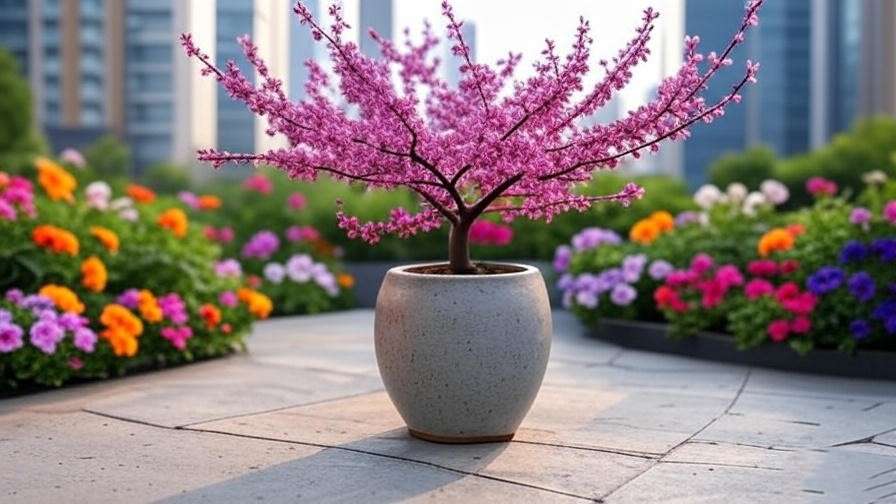
Oklahoma Redbud (Cercis reniformis ‘Oklahoma’) 🌟
The Oklahoma Redbud is a heat-tolerant variety with glossy, dark green leaves and vivid magenta flowers. Growing 15–25 feet tall, it’s a favorite in southern climates for its disease resistance and compact form.
- Best For: Southern gardens, ornamental focal points, or mixed borders.
- Unique Traits: Shiny foliage and intense bloom color.
- Care Tips: Plant in full sun for best flowering. Prune lightly to maintain shape, and mulch to protect roots in hot summers.
Other Notable Varieties 🌼
- Texas Redbud (Cercis canadensis var. texensis): A compact, heat-tolerant variety with smaller leaves and vibrant blooms, ideal for southern gardens.
- Mexican Redbud (Cercis canadensis var. mexicana): Features unique wavy-edged leaves and a shrub-like form, perfect for arid landscapes.
- ‘Covey’ (Lavender Twist): A weeping redbud with cascading branches, creating a dramatic focal point in small gardens.
| Variety | Height | Bloom Color | Hardiness Zones | Best Use |
| Eastern Redbud | 20–30 ft | Pink-Purple | 4–9 | Large yards, woodland gardens |
| Western Redbud | 10–20 ft | Magenta | 6–9 | Xeriscaping, sunny slopes |
| Chinese Redbud | 8–15 ft | Pink | 6–9 | Small spaces, containers |
| Oklahoma Redbud | 15–25 ft | Magenta | 6–9 | Southern gardens, focal points |
| Texas Redbud | 15–20 ft | Pink-Purple | 6–9 | Hot climates, mixed borders |
| Mexican Redbud | 10–15 ft | Pink | 7–9 | Arid landscapes, shrub borders |
| ‘Covey’ (Lavender Twist) | 5–10 ft | Lavender-Pink | 5–9 | Small gardens, focal points |
How to Choose the Right Redbud Tree for Your Garden 🧑🌾
Assessing Your Garden’s Conditions
Before selecting a redbud, evaluate your garden’s environment:
- Climate and Hardiness Zones: Check your USDA zone (most redbuds thrive in zones 4–9). Western Redbuds excel in drier zones, while Eastern Redbuds tolerate colder winters.
- Soil Type: Redbuds prefer well-drained, loamy soil with a pH of 6.0–7.0. Test your soil to ensure compatibility.
- Sunlight: Most redbuds need full sun (6+ hours daily) for optimal blooming, though some tolerate partial shade.
Matching Redbud Varieties to Your Needs
Consider your garden’s purpose and constraints:
- Aesthetic Goals: Want a bold focal point? Try the Oklahoma Redbud. Prefer a delicate accent? The weeping ‘Covey’ is ideal.
- Space Constraints: For small yards or patios, choose compact varieties like Chinese Redbud or ‘Don Egolf.’
- Maintenance Level: Low-maintenance options like Western Redbud suit busy gardeners, while Eastern Redbud may require more pruning in humid areas.
Expert Tips for Selection
- Support Local Wildlife: Redbuds attract bees, butterflies, and hummingbirds, boosting biodiversity.
- Plan for Growth: Account for mature size to avoid overcrowding. For example, Eastern Redbuds need more space than Chinese Redbuds.
- Mix Varieties: Combine early-blooming Eastern Redbuds with late-blooming Chinese Redbuds for extended spring color.
Planting and Caring for Redbud Trees 🌱
Planting Your Redbud Tree
- Best Time to Plant: Early spring or fall, when temperatures are mild, promotes root establishment.
- Step-by-Step Guide:
- Choose a site with well-drained soil and adequate sunlight.
- Dig a hole twice as wide and as deep as the root ball.
- Place the tree, ensuring the root collar is level with the soil.
- Backfill with native soil, water thoroughly, and mulch around the base.
- Common Mistakes: Avoid planting too deep or in poorly drained soil, which can cause root rot.
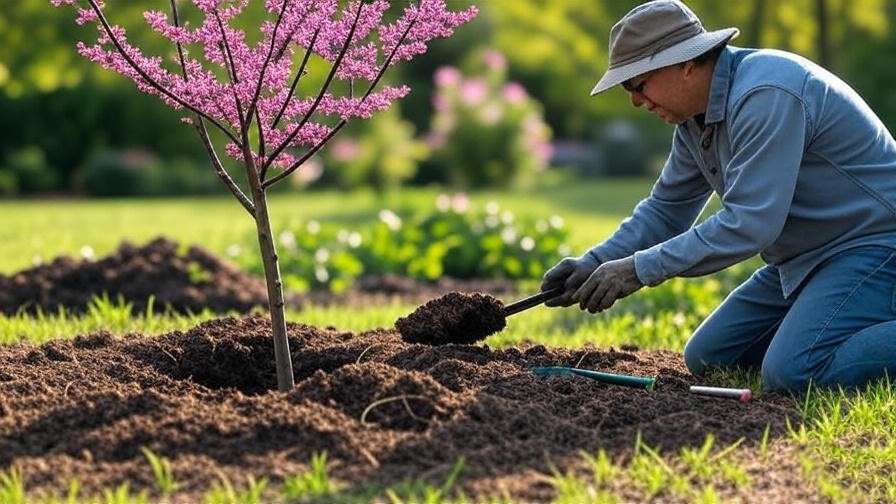
Watering and Fertilizing
- Young Trees: Water deeply once a week during the first year, especially in dry spells.
- Established Trees: Reduce watering to every 2–3 weeks, depending on rainfall.
- Fertilization: Apply a balanced, slow-release fertilizer (e.g., 10-10-10) in early spring. Organic options like compost or fish emulsion work well.
- Signs of Stress: Yellowing leaves may indicate overwatering or nutrient deficiency. Adjust care accordingly.
Pruning and Maintenance
- When to Prune: Late winter or early spring, before buds form, is ideal for shaping and removing deadwood.
- How to Prune: Use clean, sharp shears to cut at a 45-degree angle above a bud. Remove crossing branches to improve air circulation.
- Seasonal Care: Mulch with 2–3 inches of organic material to retain moisture and protect roots. In winter, wrap young trees in burlap in colder zones to prevent frost damage.
Common Pests and Diseases
- Issues: Canker, verticillium wilt, and leaf-eating insects like caterpillars can affect redbuds.
- Control Methods:
- Organic: Use neem oil for pests or remove affected branches to prevent canker spread.
- Chemical: Fungicides may be needed for severe wilt cases; consult a local extension service.
- Prevention: Ensure proper spacing, avoid overwatering, and monitor for early signs of stress.
Design Ideas: Incorporating Redbud Trees in Your Landscape 🏡
Redbuds as Focal Points
Redbud trees, with their vibrant spring blooms and elegant forms, make exceptional focal points in any garden. A single Eastern Redbud, with its canopy of pink-purple flowers, can anchor a front yard, drawing the eye and creating a welcoming atmosphere. For a dramatic effect, consider the weeping ‘Covey’ (Lavender Twist), whose cascading branches add a sculptural element to lawns or courtyards. Pair redbuds with low-growing ground covers like creeping thyme or sedum to highlight their structure without competing for attention.
- Tip: Place a bench or garden feature near your redbud to create a cozy seating area, perfect for enjoying its seasonal beauty.
Redbuds in Mixed Borders
Redbuds shine in mixed borders, where their blooms and foliage complement other plants. Combine an Oklahoma Redbud with evergreen shrubs like boxwood or dwarf conifers for year-round structure. Underplant with perennials such as hostas, daylilies, or coral bells to add texture and color contrast. The purple foliage of ‘Forest Pansy’ pairs beautifully with silver-leaved plants like lamb’s ear, creating a striking visual harmony.
- Design Idea: Create a spring-themed border with redbuds, azaleas, and tulips for a vibrant seasonal display.
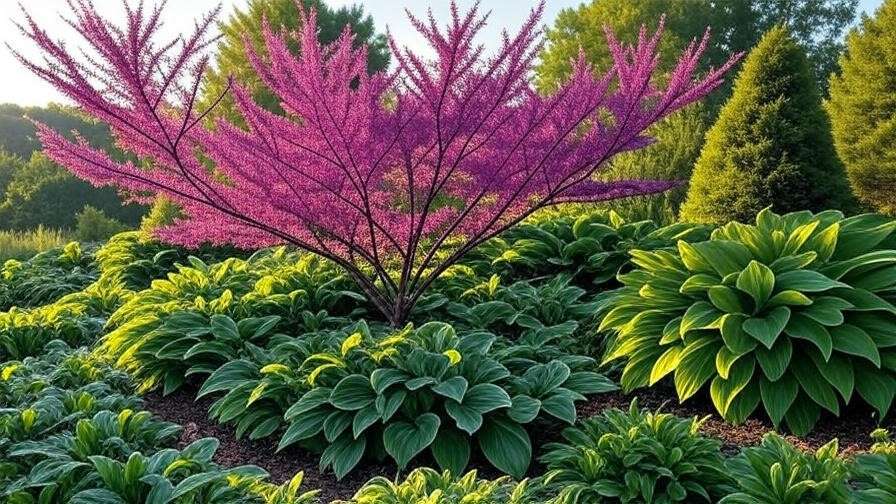
Redbuds for Small Spaces
For urban gardens or patios, compact varieties like the Chinese Redbud or ‘Don Egolf’ are ideal. These trees thrive in containers, allowing you to bring their beauty to balconies or small courtyards. Use a large, well-draining pot with a mix of potting soil and compost, and ensure the container has drainage holes to prevent waterlogging. The weeping ‘Covey’ also works in tight spaces, adding vertical interest without overwhelming the area.
- Tip: Elevate containers on risers to improve drainage and showcase the tree’s form.

Inspiring Examples
- Case Study 1: A suburban homeowner in Virginia used an Eastern Redbud ‘Forest Pansy’ as a centerpiece in their front yard, surrounded by native wildflowers like black-eyed Susans. The purple foliage contrasted beautifully with the yellow blooms, creating a low-maintenance, pollinator-friendly garden.
- Case Study 2: A California landscaper incorporated Western Redbuds into a xeriscaped hillside, pairing them with lavender and ornamental grasses. The drought-tolerant design thrived with minimal irrigation, showcasing the redbud’s adaptability.
- Visual Idea: A small urban patio featured a container-grown ‘Avondale’ Chinese Redbud, accented with colorful annuals like petunias, creating a vibrant outdoor living space.
Environmental and Ecological Benefits of Redbud Trees 🌍
Redbud trees are more than just ornamental—they’re ecological powerhouses. Their early spring blooms provide nectar for pollinators like bees, butterflies, and hummingbirds, supporting local biodiversity. In urban settings, redbuds help mitigate the heat island effect by providing shade and cooling the air. Their root systems stabilize soil, reducing erosion on slopes or in areas prone to runoff. Additionally, redbuds contribute to carbon sequestration, making them a sustainable choice for eco-conscious gardeners.
- Fun Fact: In some cultures, redbud flowers are edible and used in salads or as garnishes, adding a unique culinary twist to their ecological value.
Frequently Asked Questions About Redbud Trees ❓
- Q: How fast do redbud trees grow?
- A: Redbuds are moderate growers, typically adding 1–2 feet per year. Eastern Redbuds grow faster in ideal conditions (rich soil, ample water), while compact varieties like Chinese Redbuds grow more slowly. Ensure proper care to maximize growth.
- Q: Can redbud trees grow in shade?
- A: Most redbuds prefer full sun but tolerate partial shade (4–6 hours of sunlight). Eastern Redbuds handle shade better than Western Redbuds, but reduced light may decrease blooming.
- Q: Are redbud trees deer-resistant?
- A: Redbuds are moderately deer-resistant, but deer may nibble young shoots or foliage in areas with high deer populations. Use fencing or deer-repellent sprays for protection.
- Q: How long do redbud trees live?
- A: With proper care, redbuds can live 50–70 years. Lifespan varies by variety and environment—Eastern Redbuds may live longer in cooler climates, while Oklahoma Redbuds thrive in hotter regions.
- Q: What’s the best redbud for a small yard?
- A: Compact varieties like Chinese Redbud ‘Avondale’ or ‘Covey’ (Lavender Twist) are perfect for small yards, offering beauty without overwhelming space.
Expert Insights: Tips from Horticulturists 🌟
Certified arborist Dr. Jane Thompson, with over 20 years of experience, shares: “Redbuds are a fantastic choice for gardeners seeking low-maintenance beauty. Their adaptability to various soils and climates makes them a go-to for both novice and experienced gardeners.”
- Lesser-Known Fact: Redbud seed pods can persist into winter, adding visual interest and serving as a food source for birds.
- Seasonal Care Calendar:
- Spring: Fertilize lightly, prune for shape, and monitor for pests.
- Summer: Water during dry spells and mulch to retain moisture.
- Fall: Plant new trees and enjoy fall foliage.
- Winter: Protect young trees from frost and check for structural issues.
Conclusion: Transform Your Garden with the Perfect Redbud Tree 🌳
Redbud trees offer unmatched beauty, versatility, and ecological benefits, making them a must-have for any garden. Whether you choose the vibrant Eastern Redbud, the drought-tolerant Western Redbud, or the compact Chinese Redbud, there’s a variety to suit every space and style. By selecting the right type and following expert care tips, you can enjoy years of stunning blooms and lush foliage. Ready to transform your landscape? Share your redbud experiences in the comments, or explore our other plant care guides for more inspiration. Subscribe for the latest gardening tips and start growing your dream garden today! 🌿

